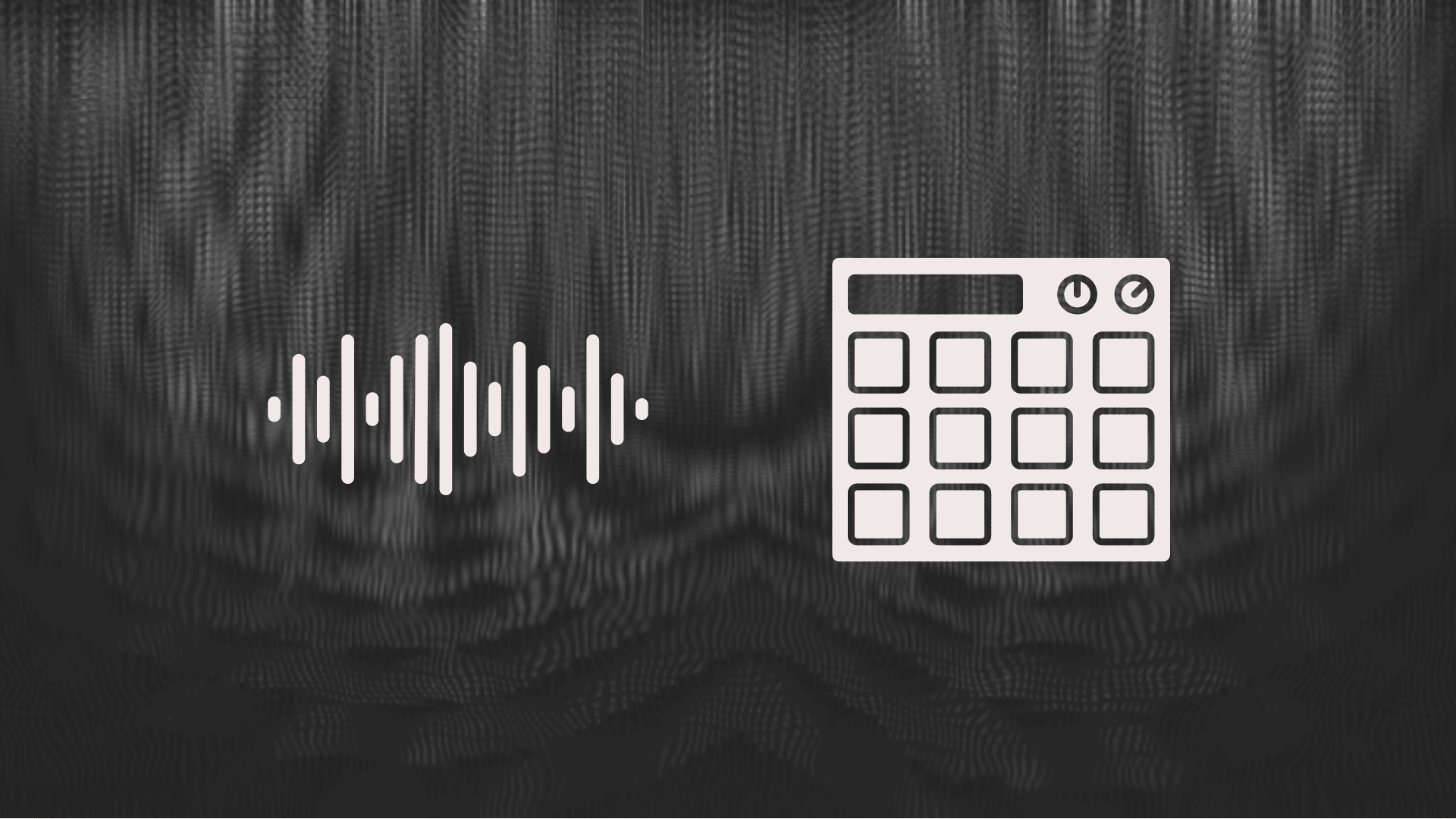So that you wish to discover ways to make techno? I don’t blame you – there’s one thing particular about that hypnotic sound that has outlined digital music for years.
Perhaps you’ve tried however you’re caught. You don’t have the fitting sounds, nothing suits collectively and every little thing you make appears like a washy mess of audio.
Don’t concern – on this information, we’ll cowl 11 of crucial methods you have to know relating to making techno. Right here’s a rundown:
- Choose the fitting type
- Thumping kicks
- It’s all within the rhythm
- Prime-end percussion
- Darkish sounds + reverb
- Go nuts with the post-processing
- Hypnotic, driving basslines
- Constructing power & stress
- Atmosphere and environment
- Hold it evolving (each 8 bars)
- The skilled polish
These newbie ideas work in any DAW (Ableton Dwell, FL Studio, Logic Professional X), so let’s have a look! ?
#1: Choose the fitting type
Techno initially began in Detroit throughout the Seventies with producers like Juan Atkins, Kevin Saunderson, and Derrick Could. They pioneered the unique uncooked, fascinating techno sound.
However like many different subgenres of digital music, techno has change into so large over time that many subgenres have been created.
You’ve received:
- Minimal Techno
- Uncooked/Deep Techno
- Peak-time Techno
- Melodic Techno
- Industrial Techno
- Hardcore Techno/Onerous Techno
As you possibly can see, there’s rather a lot. However most techno suits into considered one of two classes: Uncooked/Deep Techno or Peak-time Techno.
A minimum of, that’s how Beatport sees it.
Uncooked/Deep Techno
That is attribute of the unique, minimal sound of techno that got here out of Detroit within the early days. It retains the hypnotic really feel, characterised by easy but efficient loops, a grungier aesthetic, and an arguably ‘darker’ sound.
Many individuals would characterize one of these techno as ‘underproduced’, however it’s simply a part of the aesthetic this breed of producers goes for.
On this type, you’d be choosing components like:
- Unique 909 drum samples
- Acid basslines
- Analog synths with a lot of bizarre modulation and FX processing
- Longer, repetitious preparations with a lot of sluggish motion over time
- Barely quicker BPMS (130-140)
Right here’s an instance of this type:
Peak-time Techno
Against this, peak-time techno has a extra trendy affect and is impressed by melodic phrases and distinctive sound design.
This new sound has been pioneered by producers like UMEK, Adam Beyer, and Charlotte de Witte.
The primary components of this sound are:
- Punchy and trendy percussion
- Use of digital synths and a number of layers
- Large builds within the breakdown, fuelled by FX sweeps
- Extra apparent variation within the association
- Slower BPMS (120-135)
Different types
There are different kinds of techno like dub techno which is much less club-oriented and extra for listening, and melodic techno which is impressed by progressive and melodic home music.
Whereas we may dive into all of those, for this text we’ll simply cowl the aforementioned types. We would do these at another level (when you’d wish to see these, e-mail me).
Really helpful: How To Make Home Music
#2: Thumping kicks
The central theme of techno is the kick drum – much more so than home music.
It is because whereas home music focuses on swing and groove, techno is all about these straight, driving rhythms.
Home additionally tends to characteristic a clap on the two and 4, whereas techno forgoes this in favor of highlighting the kick.
Should you’re going for the uncooked techno sound, a boomy, 808, or 909 type kick would work properly right here. This creates that ‘wash’ of low finish that rumbles all through the membership:
909 Kick (135BPM):
Nevertheless, when you’re going for the fashionable peak-time techno type, a shorter kick with numerous punch might be your finest guess. Plenty of low-end continues to be key, however these kicks have a a lot tighter sound.
Fashionable Techno Kick (132BPM):
For this information, I’ll go for the peak-time techno kick.
When you’ve chosen a pattern, you’ll wish to program a easy 4-on-the-floor kick sample like so.
That is the muse of techno proper right here – every little thing else will encompass this core theme.
You need the kick to maintain this sample up for almost all of your monitor, in addition to within the breakdown.
Nevertheless, you possibly can nonetheless spice issues up with plenty of:
- programming further kicks between them
- eradicating the kick fully in direction of the top of a bit
- utilizing reverse kicks
Right here’s what I got here up with utilizing the following tips:
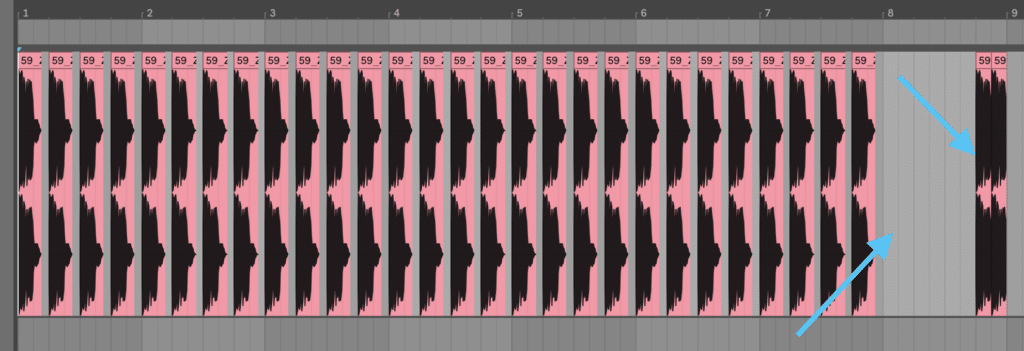
I haven’t used a reverse kick right here, however I’m going to do one thing cool in a while as an alternative.
For now, let’s transfer on to the opposite drum sounds!
#3: It’s all within the rhythm
When you’ve received a kick down, you possibly can program further percussion hits like claps and snares across the kick.
As I discussed, you don’t have to stay to the usual 2 and 4 like in home music.
You should utilize claps and snares as an energy-building tactic and be extra inventive with the rhythm.
Listed below are a number of methods you are able to do this:
Syncopated Percussion
Syncopation is the place you program a drum sound to ‘really feel’ prefer it’s taking part in at a special tempo to the remainder of the monitor.
It is a nice attention-grabbing method, and lots of techno producers use this to modify up totally different sections.
It’s commonest to make use of snares to do that, however you possibly can be at liberty to search out toms or some other perc sound. Right here’s the snare I’m utilizing:
I added a high-pass filter to the unique pattern to ensure the kick has house within the low finish. It is a good follow for sure samples.
I’m going so as to add an offbeat syncopated snare round 1.1-1.2, after which once more at 2.3-2.4. I’ll repeat this sample each 2 bars.
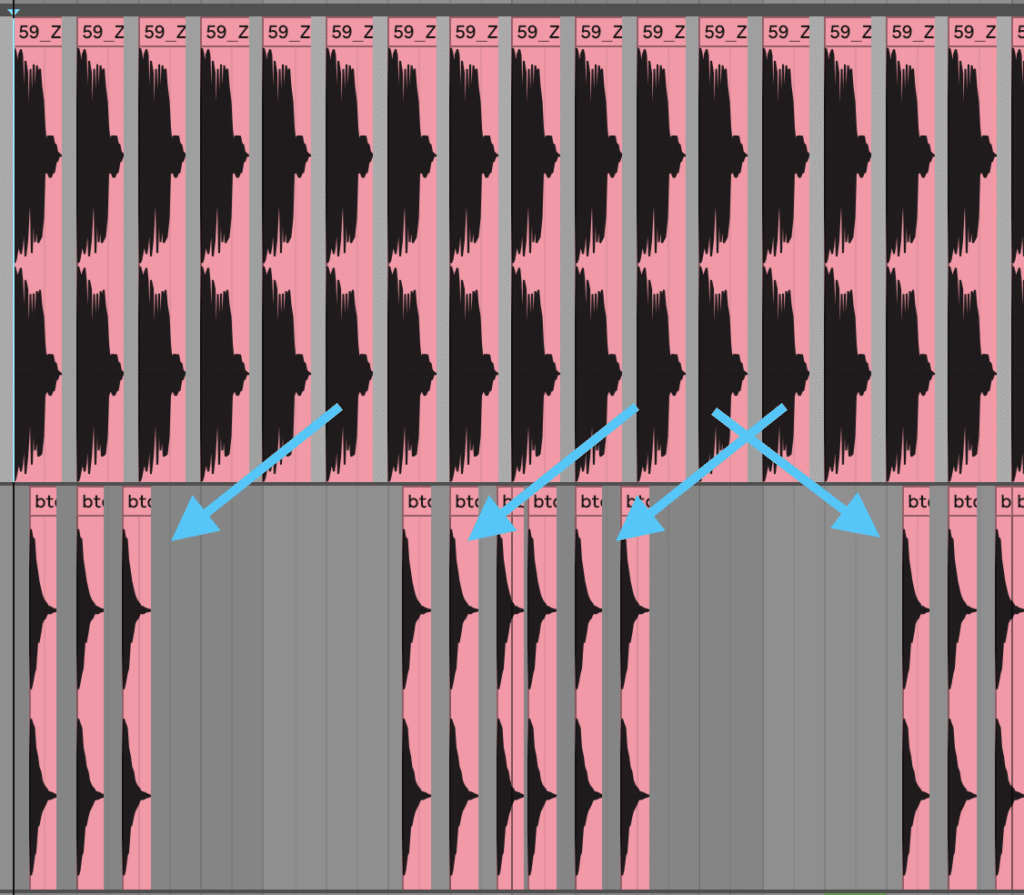
You possibly can see the 2 syncopated rhythms mix into each other on the finish of each 2 bars.
Rolls
A good way so as to add power in techno, particularly after an enormous construct, is to abuse the claps by what I wish to name rolls.
You simply line them up each 1/sixteenth be aware for some time and allow them to hearth like a machine gun.
However I discover this works higher with claps than snares, so let’s discover a good clap pattern:
I could use them extra liberally later within the monitor, however for now, I’m going to make use of them each 4 bars at 4.2.
This creates an additional little little bit of stress and acts as a ‘name and response’ with the snare:
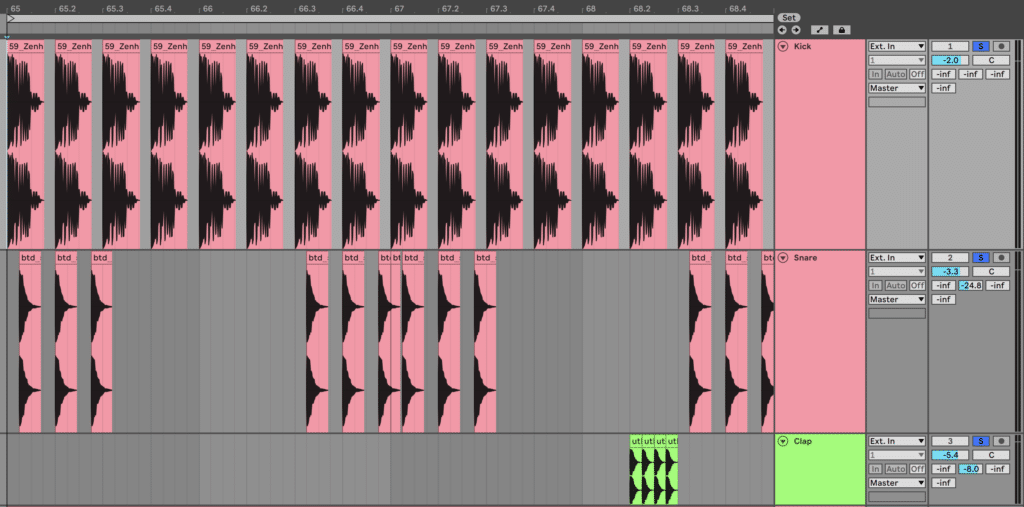
This sounds particularly cool if you give them a little bit of reverb. And talking of reverb…
Reverb Hits
As a result of techno is all about filling in house across the kick with percussion and sound, reverb can be utilized to fill these gaps.
The best manner to do that is to arrange a reverb ship with a 1-2s decay time and ship sure hits to it. I’m going to make use of Valhalla Classic Verb, however you should utilize any plugin or inventory system.
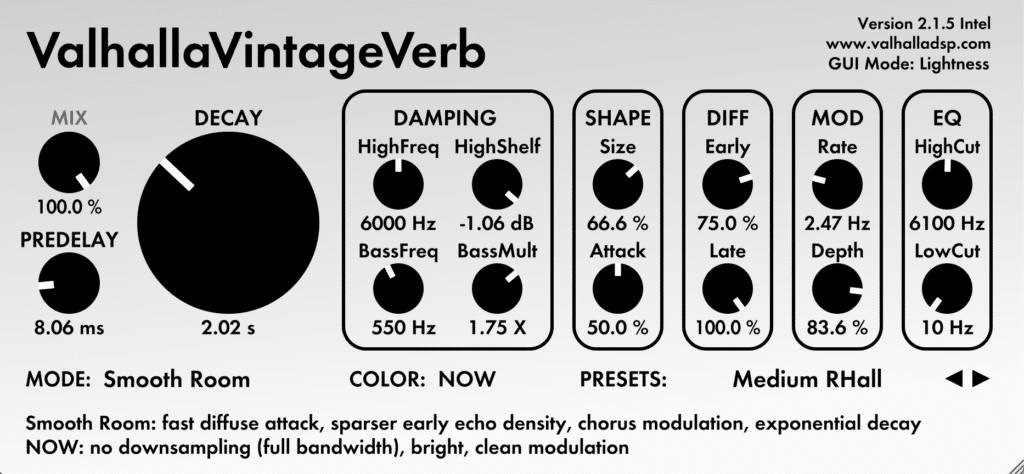
I’m going to ship my claps to it, in addition to my snares (somewhat bit much less).
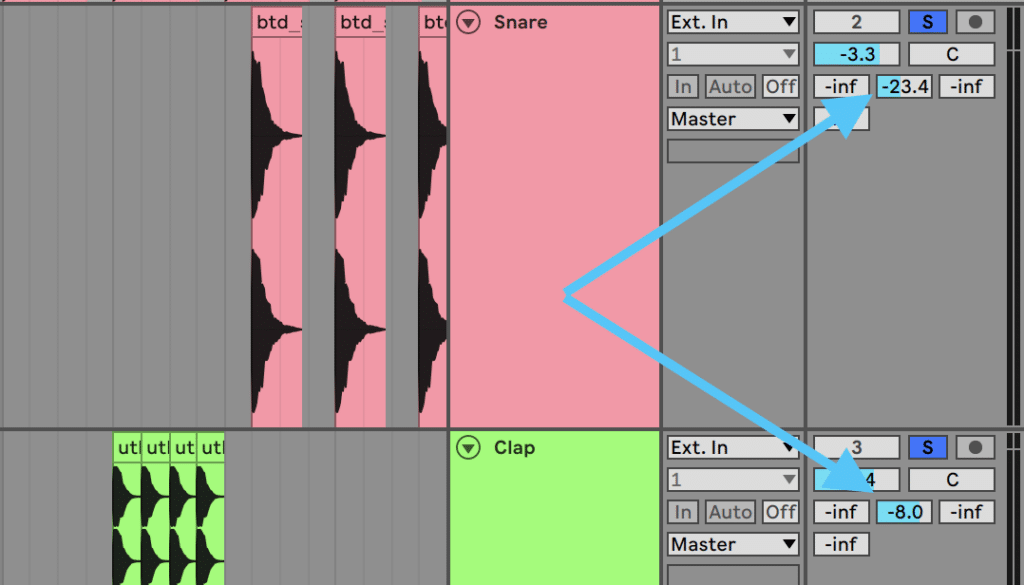
Discover the way it fills out the house extra:
When you get your principal percussion hits down, you possibly can flip to the top-end percussion to create power.
#4: Prime-end power (cymbals)
As a result of techno is closely focussed on the kick, you wish to compensate with a lot of power within the tops, utilizing hats and rides.
As soon as once more, the 909 drum machine sounds an ideal start line right here, however you possibly can go additional with extra trendy forms of techno.
You’ll wish to begin with constant 1/eighth and 1/sixteenth rhythms. Here’s a normal 1/sixteenth hat over what we’ve been making to this point:
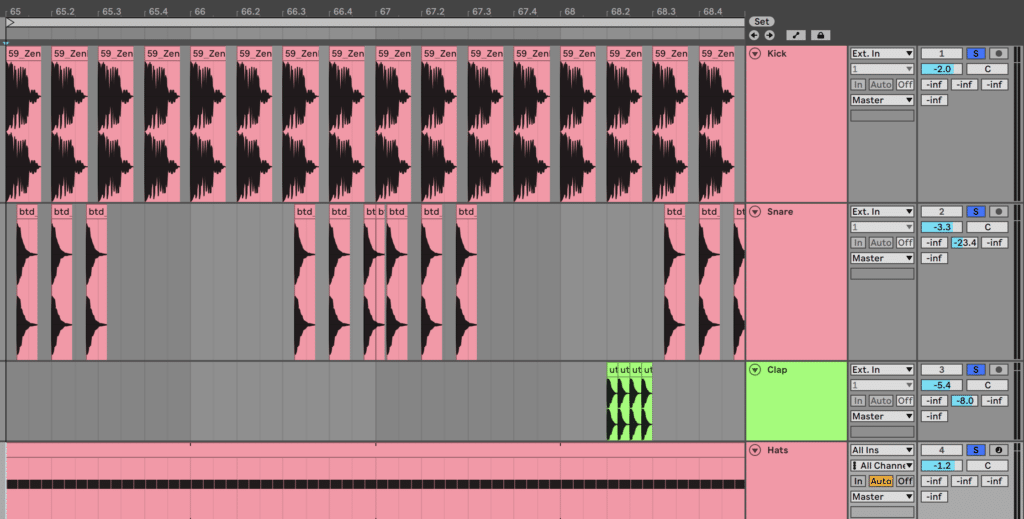
That is stable, however it’s somewhat stale. Let’s add some velocity modifications to make the hats ‘dance’ a bit.
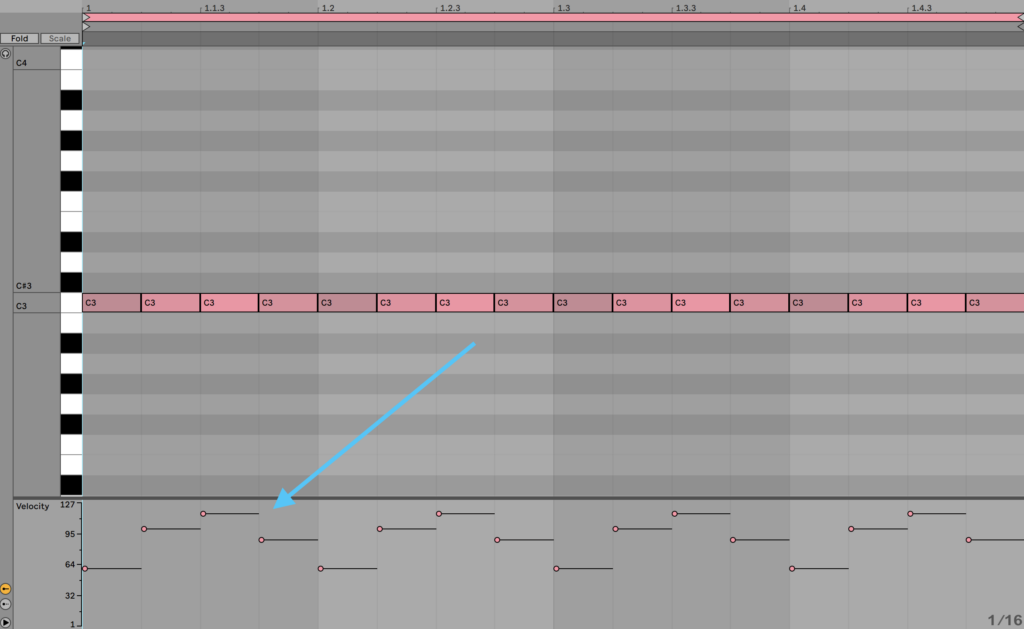
Now we’re beginning to get that ‘driving really feel’ that techno is thought for.
However we are able to create much more power by layering in some rides.
I’m going to make use of a 909-like trip pattern on each 1/eighth be aware, with a number of velocity modifications on each 1st and third it so it ‘geese’ with the kick.
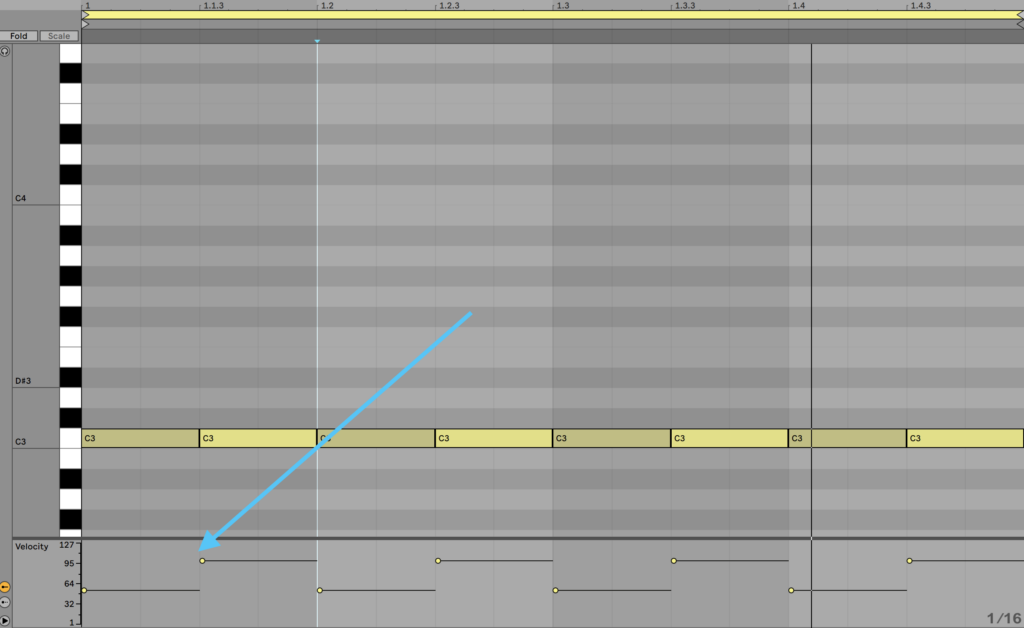
Now we’re speaking.
Bonus tip: a enjoyable method to make hats extra ‘hypnotic’ is to make use of timed delays, making a rhythmic sense of house. Let’s add a 3/16 delay to the rides:
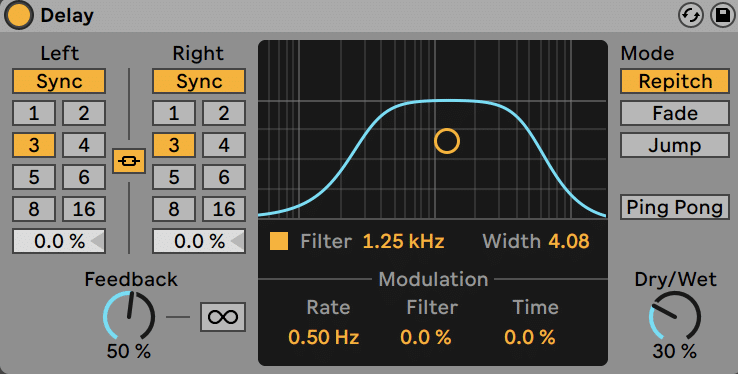
#5: Darkish sounds with reverb
One of many principal options of techno is its deal with atonal and dark-sounding melodies. A part of the enjoyable is that you simply don’t even have to stay to a conventional scale when you don’t wish to.
The ‘hook’ in techno tends to be an array of sounds which might be organized to create a phrase. These are often processed with reverb to place them in an area.
You possibly can hear this within the following monitor, between the vocal cuts and the acid bass stabs:
On this case, I’m going to choose 2 sounds: a bell and a vocal snippet. Between these two, I’ll have the ability to provide you with one thing attention-grabbing.
Right here’s the bell pattern I’m utilizing:
and the vocal snippet:
I’ll load each of them right into a sampler every, and use the next methods to provide you with one thing attention-grabbing:
- pitching samples up and down
- altering the pattern begin time
- alternating notes and pitches
- making an attempt totally different positions within the association
There’s no proper or unsuitable manner to do that right here. Right here’s what I got here up with:
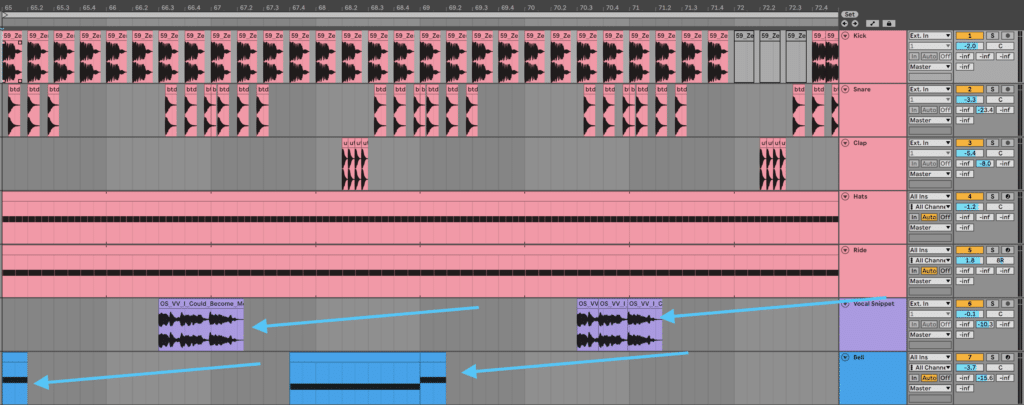
I feel these are each sounding good, and I’ve put them by the identical reverb as earlier than.
However we are able to do extra with a little bit of post-processing.
#6: Go nuts with the post-processing
Techno is all about that other-worldly sound, so you are able to do some inventive processing to get issues sounding actually unusual, even past reverb.
Delay
Delay is considered one of my favourite results to make use of in techno as a result of it’s rhythmic and creates a ‘cavernous’ feeling.
Should you’re going for that old-school sound, you should utilize one thing like a tape echo in lieu of a digital delay impact.
I selected to make use of delay on my vocal with a 3/sixteenth delay time, giving it a pleasant sense of house:
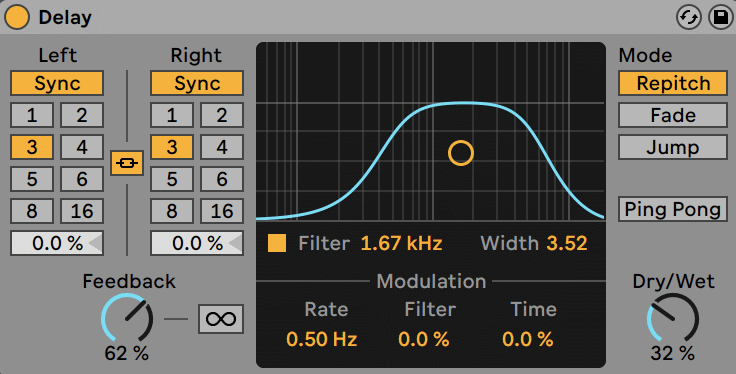
Amp Simulation and Distortion
Amp simulations are nice for getting distinctive, gritty textures out of any sound. Nevertheless, you’ll wish to watch out to drive issues too exhausting too early.
On this case, I wished to soiled up the bell sound to make it sound like one thing unrecognizable.
So I used the ‘Clear’ preset for Ableton Dwell’s Amp system from the default library and tweaked the drive to style.

Mixed with that reverb and pitch alternation, now we have ourselves a spooky, crunchy bell-like texture.
EQ
Usually EQ is used as a mixing software, however it could possibly make for a superb inventive one too.
As a result of the vocal pattern is sort of lo-fi, trying to ‘repair’ it by including again within the high-end caused some cool noisiness to the unique sound.
Right here’s the curve I made utilizing FabFilter Professional-Q 3. Observe that this appears actually difficult, however it was actually simply me throwing random boosts and cuts in there:
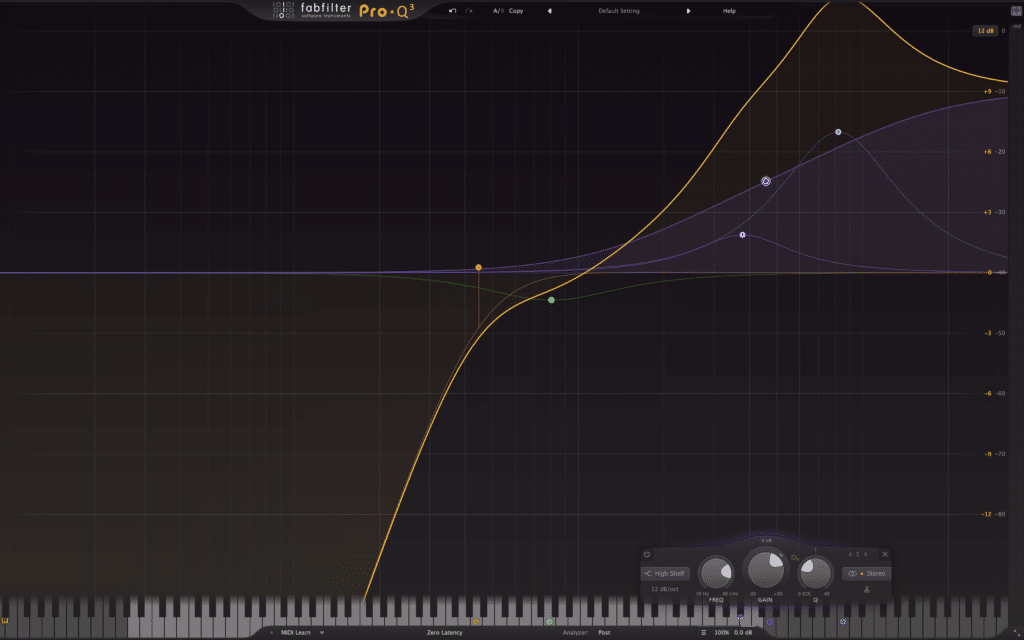
We will additionally apply these kinds of processing methods to the remainder of our monitor as we go.
#7: Hypnotic bass line
In techno, the bassline performs a comparatively constant position, filling within the low finish with a driving, arpeggiated rhythm.
Because of this, utilizing arpeggiators is frequent in techno, particularly with the basic sound of the TB-303 bassline synth.
Within the monitor I’m making, I’m going to make use of a extra trendy sound from Ableton Dwell’s Wavetable synth – the ‘Neo Publish Acid’ preset.

Once more, you possibly can actually get away with no matter notes you want in techno – so long as it feels proper to you and is hitting the fitting be aware vary.
Between E0 and E1 works for me typically, as that is often reproduced by a subwoofer in a membership.
In techno, sure bass patches do sound higher once they depart house for the low-end of the kick and play within the greater ranges.
Listed below are the 2 notes I’m utilizing – F0 and A0:
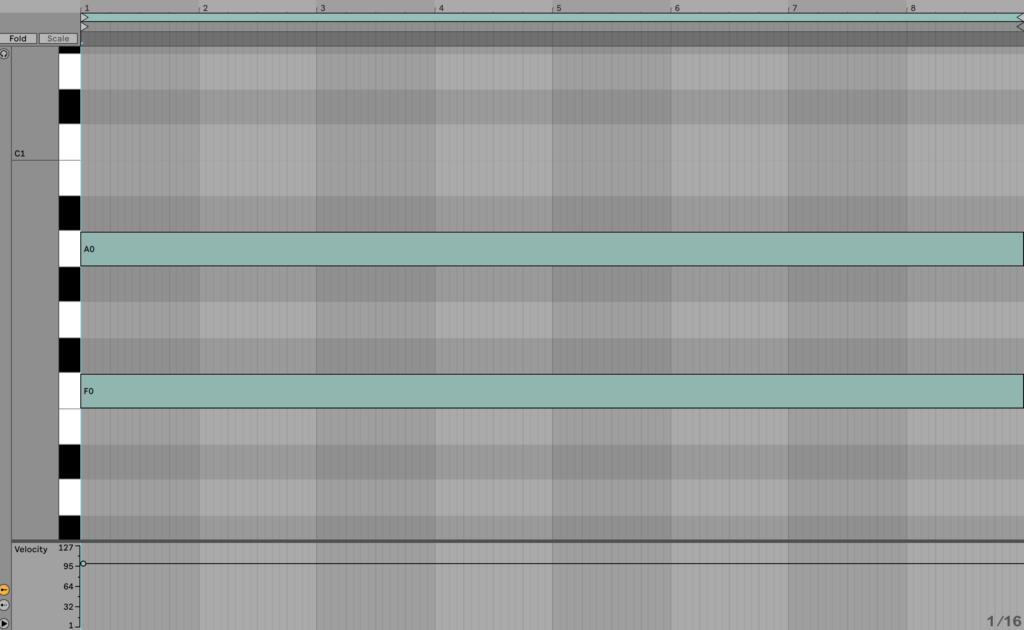
This has a pleasant sort of sub-bass really feel. Now it’s time to make use of an arpeggiator.
Most DAWs include both an arpeggiator system (Ableton Dwell, Logic Professional X) or an arpeggiation perform (FL Studio Piano Roll menu).
As I’m in Ableton, I’ll use its built-in system. I’m going to set the rhythm to 1/16, the gate to 99% (full-length notes), and the ‘Steps’ to 1, so it jumps the octave each 2nd repeat.
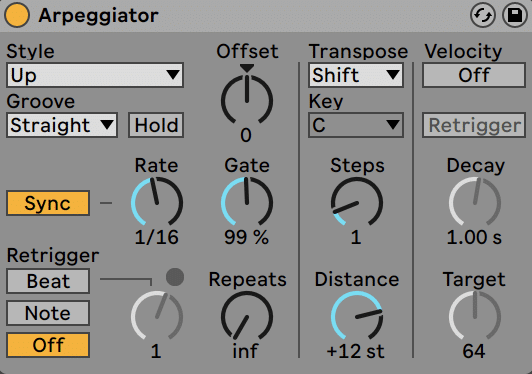
Be happy to tweak the preset to style – I personally preferred to have the LFOs synced to a straight rhythm (1/4th or 1/eighth) fairly than a syncopated one (e.g. 3/sixteenth).
I additionally wish to play with the filter cutoff to get some good movement and power over time. I’ve modulated it with the LFO as properly and pushed it fairly closely.
Lastly, I tweaked the wavetable place somewhat to get a barely totally different tone out of the bass.

No matter you find yourself coming with, be sure to sidechain the bass to your kick drum, because the sub-frequencies shall be getting fairly stuffed up now, and also you don’t need too many frequency clashes.
#8: Constructing power and stress
By now you’ll most likely have a stable 8-bar loop, however now it’s time to interrupt out of that and construct some stress. As a result of techno is all in regards to the lengthy sport.
Duplicate your 8 bar loop at the very least 4 occasions, so you have got 32 or extra bars to work with.
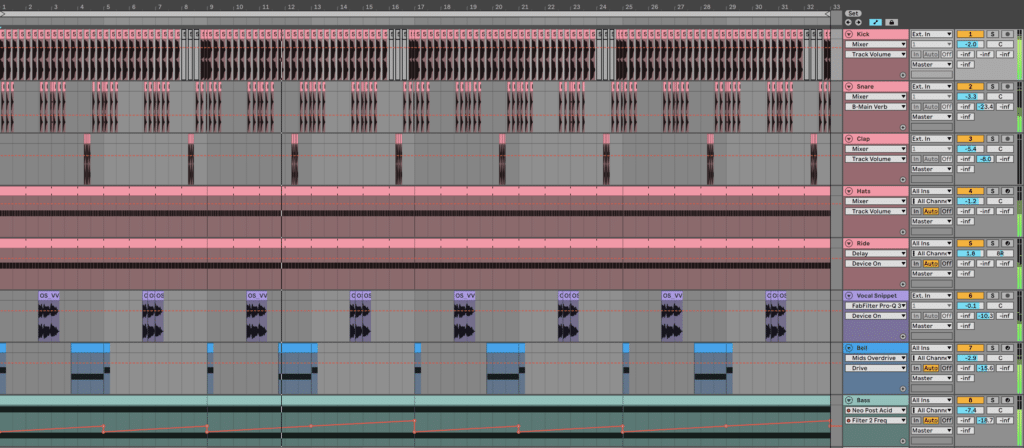
Now we are able to add in extra appears like FX, sweeps, and impacts. These will assist to carry up the power ranges in sure sections.
Lengthy Influence
I’m going to start out by bringing in a protracted noise influence.
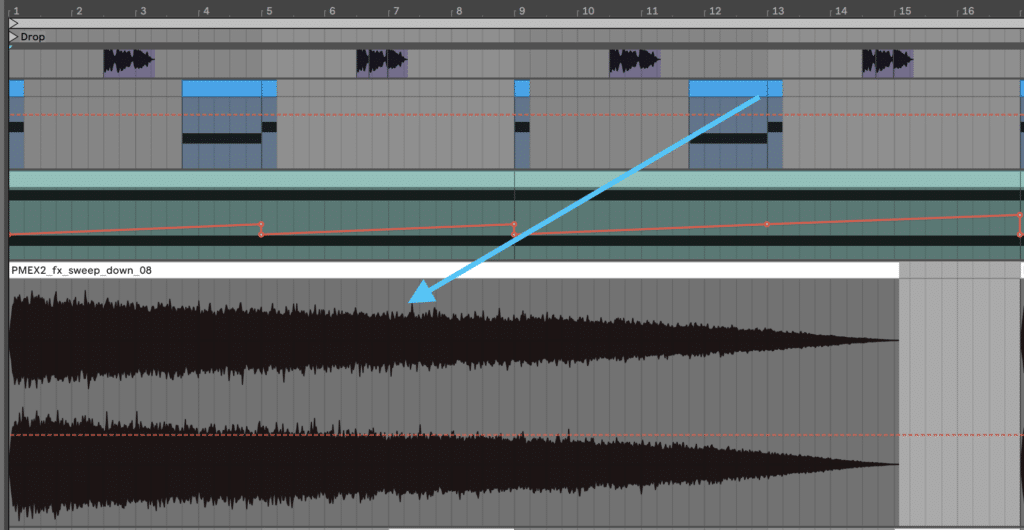
This kind of sound signifies the beginning of a brand new part and retains up the power.
This specific pattern lasts practically 16 bars, however yours could also be shorter. It will simply hold issues attention-grabbing because the loop evolves.
I’m simply going to put it on the primary beat of each 16 bar phrase. Typically offsetting the rhythm by a beat or two earlier than or after the 1 can work as properly.
Metallic Sweeps
Metallic textures work properly in techno as a result of the tones will be fairly jarring with out becoming to a traditional key.
I like so as to add some form of delicate sweep each 8 bars, which creates anticipation for the following part.
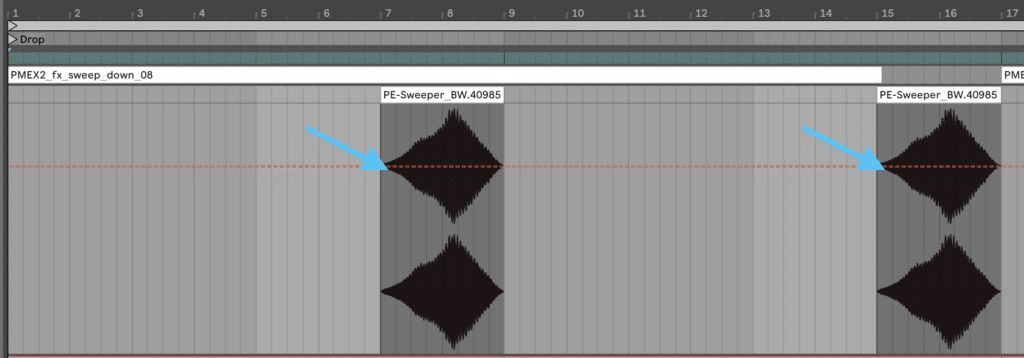
You should utilize noise sweeps as properly to layer them up when you like.
#9: Atmosphere and environment
A part of the sound of techno is the atmospheric components that swirl round within the background, placing your entire monitor in a special place.
Reverse Kick & Reverb
Certainly one of my favourite kinds of environment for techno is taking the kick and turning that right into a swelling mattress of sound.
This creates that low-end increase, and in some techno tracks, it even replaces a traditional bassline.
On this case, ours shall be extra delicate. Right here’s my course of for doing this:
- Copy the kick channel
- Add a >1s reverb at 100% moist – be certain it has loads of low finish
- Bounce an 8 bar part to audio
- Reverse the 8 bars so the reverb sweeps into the kick
- Use a low cross filter to take all of the mids and highs out
- Decrease the amount so it doesn’t take over the combo
Right here’s how mine turned out!
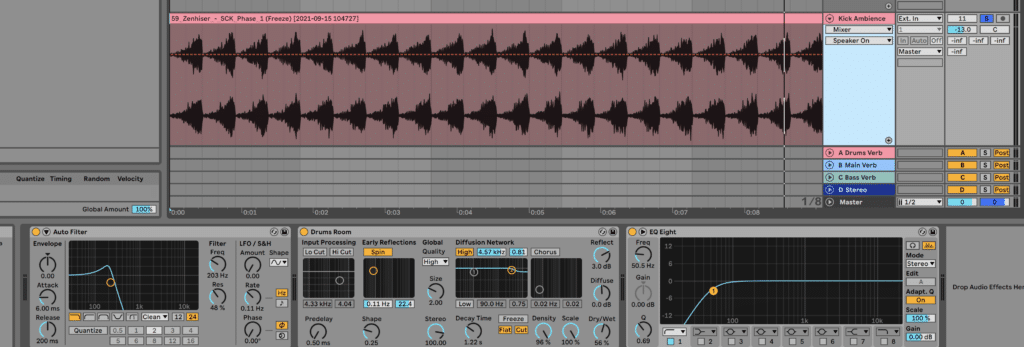
and with the unique kick:
Subject Recordings
Utilizing reverb and delay on area recordings takes pure sounds and fully twists and mangles them.
Discovering a 1 bar, 2 bar or 4 bar loop inside these longer recordings usually emphasizes the rhythmic nature of the monitor.
A couple of good candidates are samples of:
- birds chirping
- industral soundscapes (metallic)
- metropolis recordings
Take this one step additional by time-stretching and pitching these recordings to provide them an eerie vibe.
I personally used a prepare area recording, looped it each 2 bars, and reversed each 2nd one so it ‘sucked again’ into itself.
I completed this off with some notch filtering and reverb results from Valhalla Supermassive:
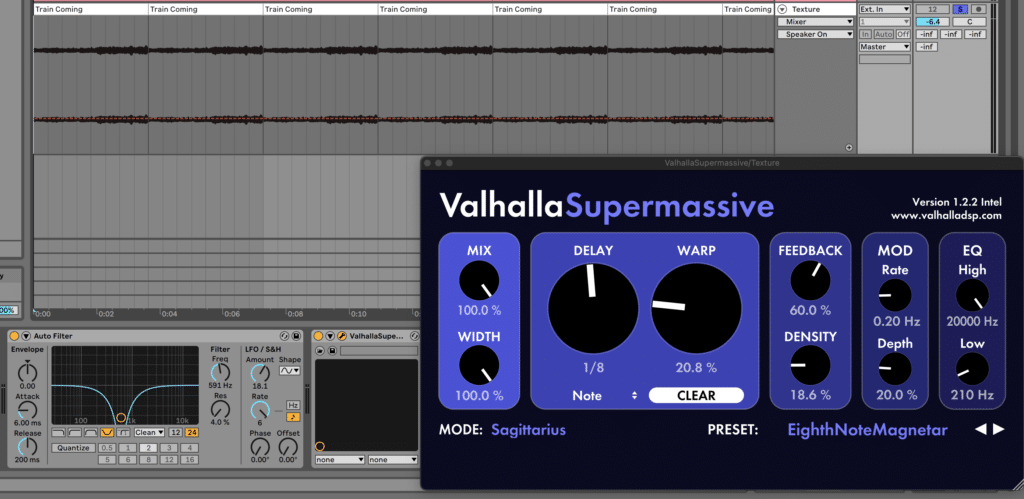
#10: Hold issues evolving (each 8 bars)
Not solely is stress and power about making sluggish modifications over time, however it’s additionally about including delicate bits of variation each 8 bars or so.
This may be so simple as:
- Including or subtracting a percussion layer
- Altering up the percussion rhythm
- Bringing in a brand new synth line
- Eradicating a whole instrument (e.g. all drums)
At this level, you’re going to be structuring your monitor and contemplating the general motion of power from intro to outro.
Right here’s a regular construction for techno and home:
DJ Intro (16-32 Bars) – Breakdown (16-32 Bars) – Drop (16-32 Bars) – Drop Variation (16-32 Bars) – Breakdown (16-32 Bars) – Drop (16-32 Bars) – Outro (16-32 Bars)
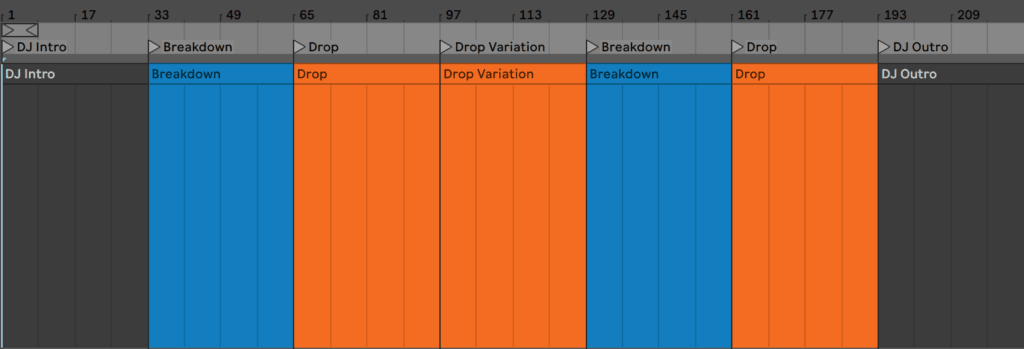
Sections will be as brief as 8 bars, however sometimes final 16-32 (2-4 repeats of 8 bars).
Right here’s a fast breakdown of every part:
DJ Intro/Outro
Having some type of drums throughout the DJ intro and outro is vital so DJs can combine it in a membership. Nevertheless, this doesn’t imply you continue to can’t get inventive.
- Use all of the drums besides the kick drum – you possibly can carry this in throughout the second 8 bars or put it aside for the drop
- Give attention to simply hats and tops throughout these sections, as they will create numerous stress
- Tease the principle hook earlier than it is available in – use filtering, quantity automation and different FX to carry it in slowly
- Use FX in direction of the top because the monitor approaches the breakdown to construct power
- Don’t simply copy-paste the intro to the outro – make some attention-grabbing modifications in order that there are at the very least some variations
Right here’s a superb instance of a peak-time techno monitor from UMEK and Cosmic Boys that does this very properly:
Breakdown
On this part, it’s vital you carry most components out fully, particularly the drums. Eradicating all drums creates probably the most distinction, nevertheless, some producers choose to maintain a hat or trip going.
That is the place you’ll introduce your principal hook in some type. You possibly can select to go away a little bit of silence earlier than to provide the breakdown most influence.
You possibly can hear this in Charlotte de Witte & Enrico Sangiuliano’s remix of The Age Of Love (round 0:35 on this video):
Within the final 8 bars of the breakdown, it would begin to construct power in direction of the drop. As soon as once more, herald FX risers and different sounds to construct it up. You should utilize claps, snares, and percussion with a fast enhance in pace to moreover create that sense of power.
Drop
The drop is the purpose of most power in your monitor, and it’s sometimes the place the kick and bass slam again in with full drive.
You possibly can hear a techno drop on this instance right here from Cosmic Boys (2:14):
You don’t have to incorporate each aspect at this level, as usually the drop variation will construct on the primary a part of the drop.
Drop Variation
As we’ve coated, techno is all in regards to the lengthy sport. So the drop power stays constant for a majority of the monitor.
Usually the power will increase throughout this part after which begins to lower in direction of the top, which is why some drop variation sections can go for 32 bars (and typically longer).
There’s no proper or unsuitable right here – simply make delicate modifications primarily based on the place you need the monitor to go.
#11: The skilled polish
When you’ve crafted your monitor, added all the weather, and are pleased with the final manufacturing, it’s time to show to the final 10%.
These are areas equivalent to:
- tightening up transitions
- eradicating pointless components
- closing synth and impact tweaks
- a full mixdown
- a grasp (non-obligatory)
I’m not going to bore you with the ten, 20, 50, or 100 tweaks I may make to my monitor.
Right here’s what I do what you to study: that these small modifications add up.
An EQ increase right here, a quantity change there, and eradicating a clap someplace all contribute to creating the best finish consequence.
A phrase of warning although: you possibly can very simply get caught right here. When you’ve been tweaking for too lengthy, name the monitor completed, export it and name it a day.
Whether or not or not you’re mastering your individual work, check it out with a limiter to see the way it sounds with an honest quantity of loudness. I personally use FabFilter Professional-L 2 for this:
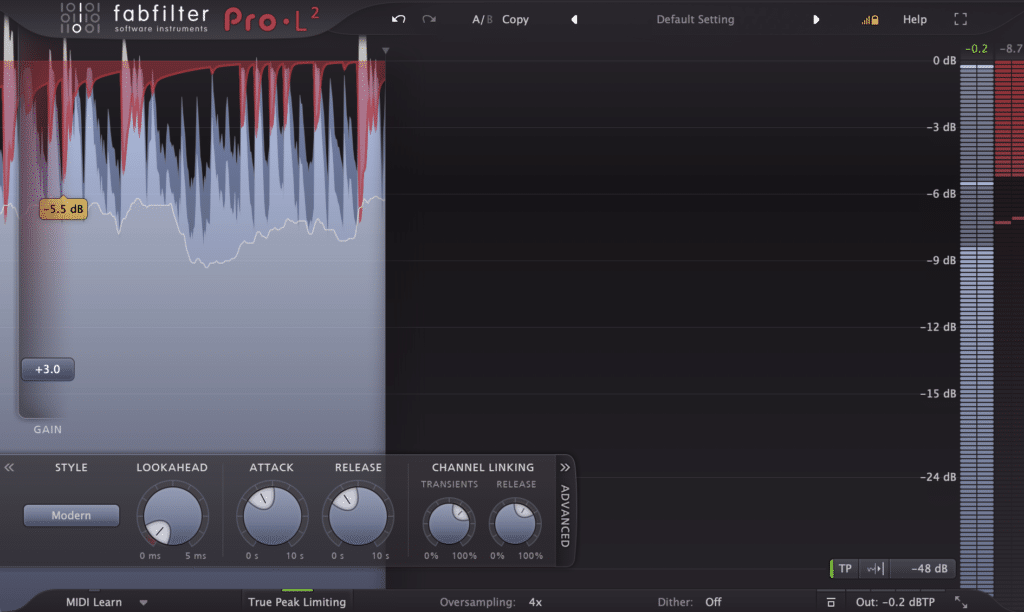
All that being mentioned, right here’s the ultimate consequence!
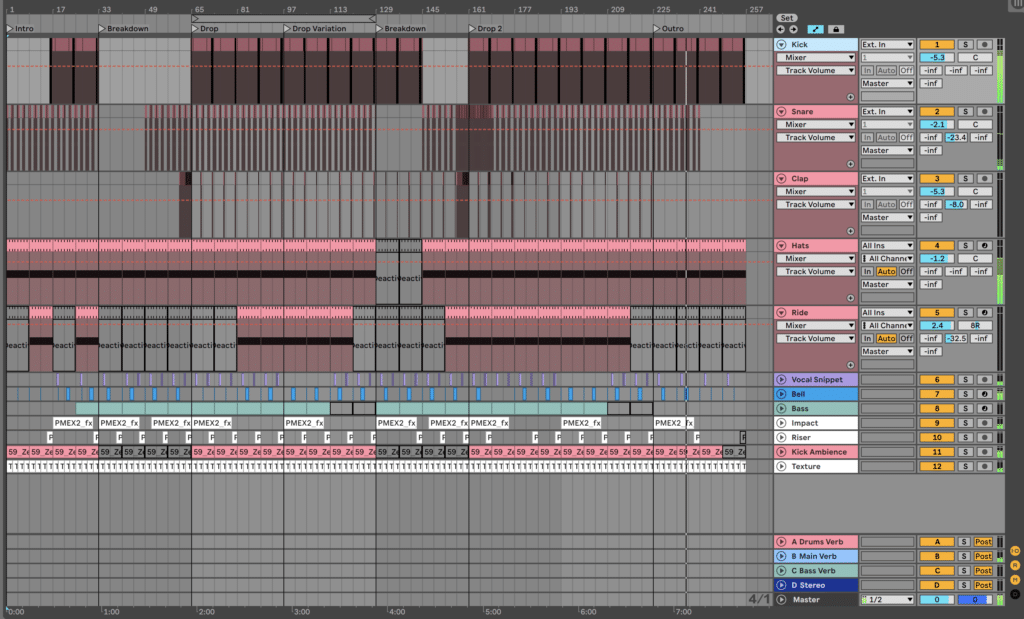
In Closing
I hope you’ve realized rather a lot about make techno. Should you apply the following tips, I’ve confidence that you simply’ll have the ability to create nice music.
However perhaps you’ve gone by all of the following tips and nonetheless really feel somewhat caught. Some stuff may need simply gone over your head.
If this sounds such as you, now we have a free video coaching for producers identical to you. You’ll study:
- The right way to re-shape your mindset in direction of music manufacturing
- A roadmap for studying every little thing you have to know
- The #1 manner producers construct stable foundational expertise
Join right here ?
